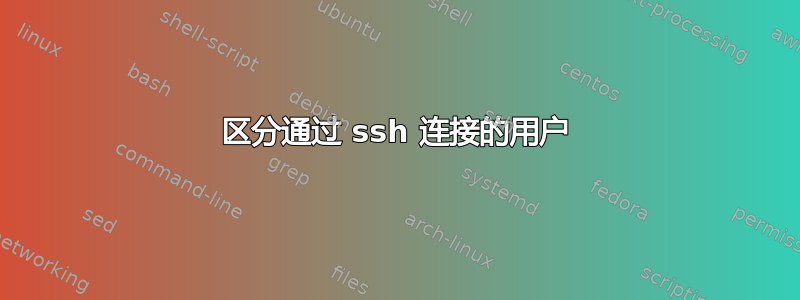
我和我的同事都使用相同的“部署”用户身份通过 ssh 连接到我们工作的 ubuntu 服务器,使用密钥登录。在我们的 rails 应用控制台中,我们有记录谁进行了更改的软件,但它无法区分我们:它只看到部署用户。有没有办法区分我们?系统是否记录了使用哪个密钥登录?这可能是我可以挂钩的一个例子,以确定我们中的哪一个人实际登录了。
请注意,这不是一个安全问题:如果我们都必须做一些略有不同的事情才能使其工作,我们都会这样做。
最明显的答案是“不要同时以‘部署’用户身份登录”,这确实可以解决问题。但我们不想这样做。
谢谢,马克斯
答案1
请注意,您可以在 authorized_keys 中的每个键后指定选项。也许可以使用该environment="NAME=value"选项并为每个键设置一个公共变量,使其具有不同的值。然后可以使用此变量来设置 bash 提示符并在脚本中使用。
以下为相关部分man sshd:
AUTHORIZED_KEYS FILE FORMAT
AuthorizedKeysFile specifies the files containing public keys for public
key authentication; if none is specified, the default is
~/.ssh/authorized_keys and ~/.ssh/authorized_keys2. Each line of the
file contains one key (empty lines and lines starting with a ‘#’ are
ignored as comments). Protocol 1 public keys consist of the following
space-separated fields: options, bits, exponent, modulus, comment. Pro‐
tocol 2 public key consist of: options, keytype, base64-encoded key, com‐
ment. The options field is optional; its presence is determined by
whether the line starts with a number or not (the options field never
starts with a number). The bits, exponent, modulus, and comment fields
give the RSA key for protocol version 1; the comment field is not used
for anything (but may be convenient for the user to identify the key).
For protocol version 2 the keytype is “ecdsa-sha2-nistp256”,
“ecdsa-sha2-nistp384”, “ecdsa-sha2-nistp521”, “ssh-dss” or “ssh-rsa”.
Note that lines in this file are usually several hundred bytes long
(because of the size of the public key encoding) up to a limit of 8 kilo‐
bytes, which permits DSA keys up to 8 kilobits and RSA keys up to 16
kilobits. You don't want to type them in; instead, copy the
identity.pub, id_dsa.pub, id_ecdsa.pub, or the id_rsa.pub file and edit
it.
sshd enforces a minimum RSA key modulus size for protocol 1 and protocol
2 keys of 768 bits.
The options (if present) consist of comma-separated option specifica‐
tions. No spaces are permitted, except within double quotes. The fol‐
lowing option specifications are supported (note that option keywords are
case-insensitive):
cert-authority
Specifies that the listed key is a certification authority (CA)
that is trusted to validate signed certificates for user authen‐
tication.
Certificates may encode access restrictions similar to these key
options. If both certificate restrictions and key options are
present, the most restrictive union of the two is applied.
command="command"
Specifies that the command is executed whenever this key is used
for authentication. The command supplied by the user (if any) is
ignored. The command is run on a pty if the client requests a
pty; otherwise it is run without a tty. If an 8-bit clean chan‐
nel is required, one must not request a pty or should specify
no-pty. A quote may be included in the command by quoting it
with a backslash. This option might be useful to restrict cer‐
tain public keys to perform just a specific operation. An exam‐
ple might be a key that permits remote backups but nothing else.
Note that the client may specify TCP and/or X11 forwarding unless
they are explicitly prohibited. The command originally supplied
by the client is available in the SSH_ORIGINAL_COMMAND environ‐
ment variable. Note that this option applies to shell, command
or subsystem execution. Also note that this command may be
superseded by either a sshd_config(5) ForceCommand directive or a
command embedded in a certificate.
environment="NAME=value"
Specifies that the string is to be added to the environment when
logging in using this key. Environment variables set this way
override other default environment values. Multiple options of
this type are permitted. Environment processing is disabled by
default and is controlled via the PermitUserEnvironment option.
This option is automatically disabled if UseLogin is enabled.
from="pattern-list"
Specifies that in addition to public key authentication, either
the canonical name of the remote host or its IP address must be
present in the comma-separated list of patterns. See PATTERNS in
ssh_config(5) for more information on patterns.
In addition to the wildcard matching that may be applied to host‐
names or addresses, a from stanza may match IP addresses using
CIDR address/masklen notation.
The purpose of this option is to optionally increase security:
public key authentication by itself does not trust the network or
name servers or anything (but the key); however, if somebody
somehow steals the key, the key permits an intruder to log in
from anywhere in the world. This additional option makes using a
stolen key more difficult (name servers and/or routers would have
to be compromised in addition to just the key).
no-agent-forwarding
Forbids authentication agent forwarding when this key is used for
authentication.
no-port-forwarding
Forbids TCP forwarding when this key is used for authentication.
Any port forward requests by the client will return an error.
This might be used, e.g. in connection with the command option.
no-pty Prevents tty allocation (a request to allocate a pty will fail).
no-user-rc
Disables execution of ~/.ssh/rc.
no-X11-forwarding
Forbids X11 forwarding when this key is used for authentication.
Any X11 forward requests by the client will return an error.
permitopen="host:port"
Limit local ``ssh -L'' port forwarding such that it may only con‐
nect to the specified host and port. IPv6 addresses can be spec‐
ified by enclosing the address in square brackets. Multiple
permitopen options may be applied separated by commas. No pat‐
tern matching is performed on the specified hostnames, they must
be literal domains or addresses.
principals="principals"
On a cert-authority line, specifies allowed principals for cer‐
tificate authentication as a comma-separated list. At least one
name from the list must appear in the certificate's list of prin‐
cipals for the certificate to be accepted. This option is
ignored for keys that are not marked as trusted certificate sign‐
ers using the cert-authority option.
tunnel="n"
Force a tun(4) device on the server. Without this option, the
next available device will be used if the client requests a tun‐
nel.
An example authorized_keys file:
# Comments allowed at start of line
ssh-rsa AAAAB3Nza...LiPk== [email protected]
from="*.sales.example.net,!pc.sales.example.net" ssh-rsa
AAAAB2...19Q== [email protected]
command="dump /home",no-pty,no-port-forwarding ssh-dss
AAAAC3...51R== example.net
permitopen="192.0.2.1:80",permitopen="192.0.2.2:25" ssh-dss
AAAAB5...21S==
tunnel="0",command="sh /etc/netstart tun0" ssh-rsa AAAA...==
[email protected]
答案2
OpenSSH 设置了一些环境变量,您可能可以使用这些变量,但前提是客户端 IP 地址对您有用。具体来说,SSH_CLIENT设置为客户端系统的 IP 地址和正在使用的端口号。
答案3
您是否知道 sudo 提供的机会?sudo 是否足够酷,可以说服您不要使用同一个帐户?使用 sudo 日志,您可以准确记录彼此正在做的事情。
你们每个人都可以连接自己的用户帐户,然后使用sudo -u deploy /yoursoftware/command param1 param2
然后在你的 sudo 日志中你会看到类似
Feb 28 xy:22:47 yourHost sudo: MaxWilliams: TTY=pts/0 ; PWD=/mount/yourCWD ; USER=deploy; COMMAND=/yourSoftware/command param1 param2
我想,您可以将其设置为使用密钥登录来运行。我假设您正在远程运行命令,而不是实际以用户 deploy 身份登录。如果是这样,那么您需要扩展这个答案。


